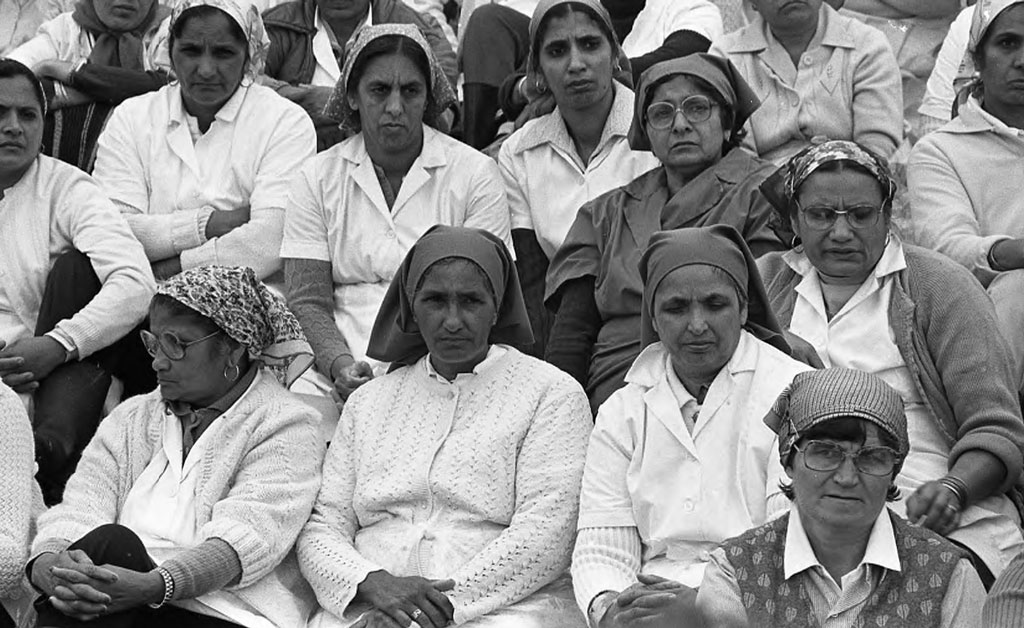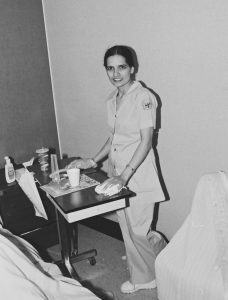
In the 1960s and 70s revised immigration laws allowed more South Asian women to enter Canada. The economy was changing too: jobs were disappearing in resource based industries like forestry. The service economy was growing. Union membership declined among private sector workers but grew in the expanding public sector, which also gained bargaining rights.
Some of these newly arrived South Asian women had marketable skills and education, often with English language skills and university-level educations – they were able to enter fields such as social work, teaching, nursing, office administration and more.
Still, many women who did not have these advantages and were limited to low-skilled and low-paid in-service work: in hotel and restaurant kitchens, cleaners and farmworkers.
Working class women’s entry to the paid labour force was often mediated by their roles as mothers and wives. On occasion it was the male household members who were IWA union members in sawmills and knew the benefits of belonging to a union who encouraged their spouses to join unions as well.
Marie Decaire, former Secretary-Treasurer of Hotel, Restaurant, Culinary Employees and Bartenders Union Local 40, one of the oldest unions in British Columbia (now known as UNITE HERE! Local 40), estimates that 15% of the membership was South Asian when she was on the executive. This membership represented workers in virtually every form of hospitality, restaurant and service industry throughout British Columbia and the Yukon. She worked alongside Rishi Sharma, an executive member originally from Fiji, who was elected chief shop steward by workers at the Hyatt Regency Hotel in Vancouver. Many Local 40 members were women and new immigrants from the wider South Asian diaspora, and were active in the union.
“I made my way up the narrow, winding road to Lillooet and when I got there, I contacted the shop steward and the shop steward set up a meeting and it turned out the shop steward was indeed Indo-Canadian and Punjabi out of the Punjab originally, although I think probably second generation; and the crew to be organised were indeed the wives, sisters, daughters and so on of Indo-Canadians living in and around the Lillooet area and primarily wanting the protection, wages and benefits that they (male family members) enjoyed in the IWA that were not available to the workers. In any event, I then, of course, went about busily trying to sign check-off cards and all these folk, they were mostly housekeeping kitchen staff and maintenance. And just overall cleaning staff at the hotel.”
“…Being in a union, being in the IWA and standing up for your rights was the way of Canadian life for them. And and you know, a lot of them had socialist backgrounds. I mean, there was the socialism that came with them. They were renegades in their own country anyway. And so there was a meshing of philosophy, if you will, between the labour movement and South Asian Canadian workers generally.”[1]
Surjit Brar worked in a unionized hospital where she became a member of the Hospital Employees’ Union (HEU). She compared work experiences in her home of Dala, Punjab to Prince George, BC:
“I came to Prince George in 1974, two years after my husband came here. When I started working at the hospital four years ago, I could not believe the wages. In India where I come from, the wage for what I do is six rupees a day, which is about one dollar. As well, the working conditions are much different here too. Coffee breaks and holidays are not like they are in India. I am glad to be working here. In Dala, there are no unions. It was something strange to me when I first started working. Unions are good because if something wrong you can say something about it. Back home, there is no criticism because everyone knows nothing will be done.”[2]
For more educated and fluent immigrants it was still a struggle to find work.
Nina Dhillon came from England to Coquitlam with her family as a teenager in the early 1980s, and later moved to Quesnel with her husband. After struggling to find a job she returned alone to the Fraser Valley. She spent a year as a farmworker before working in a kitchen at a non-unionized health care facility. Though initially not a union supporter, she eventually helped to organize the union at her work and was subsequently hired by the Hospital Employees Union (HEU) to organize and assist other workers.
Nina defied cultural and societal norms multiple times in her life. Her decision to seek work after marriage was a challenge; even more so to go to Abbotsford alone to find a job. Eventually, her husband joined her, and together they navigated non-traditional gender roles with Nina as the breadwinner and her husband raising their children.
“I was not a stay at home person. I was one that wanted to be out there to be working, and that day when I did leave, it was against my husband’s will… [I] went to India when I was pregnant. Upon coming back from India is when my husband says no need, that we need to find something that you would be happy doing for the rest of your life… He had to quit his job, right. So the decision was made that he would leave his job there. And I made the decision that I will work while he raises the children. And that’s even up until today. That is exactly what’s happened… So when we decided that I would be working, it was only because I spoke English. He didn’t have education other than the mill job that he was doing in Quesnel, where English wasn’t a big issue there, right. It was just labour that he was doing… it was easy for him to go and look for a job where education wasn’t a factor for him. So that was one of the biggest reasons.”[3]
Baljit Kaur, who was educated as a teacher in India, recalled how she ended up in the northern city of Prince George:
“A lot of my students were here in Prince George and BC in general. There was this one student of mine, he became so close to me when he was my student in India. He told me to come to Canada to meet him. When I came here, he asked me if I wanted to stay and live here then I should apply. A week later, I went to the immigration office, the immigration officer started laughing. He said, “Who would not like to have you in our country?” and within one month, I became a Canadian.”[4]
While this demonstrates the relative privilege in which educated female South Asian immigrants possessed when they entered the BC workforce, it doesn’t mean that their integration came easily. Baljit “Bally” Bassi recalled:
“I would apply for jobs and I would speak on the phone and it was all amazing. Everyone was pleasant, receptive and so forth. And there was one organization I won’t name, they’d asked me to come in and drop off my cover letter and resume when I phoned them. When I went down there I couldn’t get past the reception, and for me, it was an eye-opening. Because I had grown up in England with racism. We had the National Front, we had a lot of racism growing up, and Vancouver and Canada was portrayed to me as a diverse country that welcomes diversity and such. And for me, having been an educated woman, I was taken aback that I couldn’t get past the receptionist.”[5]
- Marie Decaire, interview by Bailey Garden, September 29, 2021. Union Zindabad! Interview Collection. BC Labour Heritage Centre. ↵
- "Surjit Keeps Surgery Ward Clean", Hospital Employees' Union, The Guardian, May 1981, 8. ↵
- Nina Dhillon, interview by Anushay Malik, May 6, 2021. Union Zindabad! Interview Collection. BC Labour Heritage Centre. ↵
- Prince George Stories, "History Across the Regions Project", South Asian Studies Institute, 2018. https://youtu.be/HNfokMpwNwU ↵
- Prince George Stories, 2018. ↵

